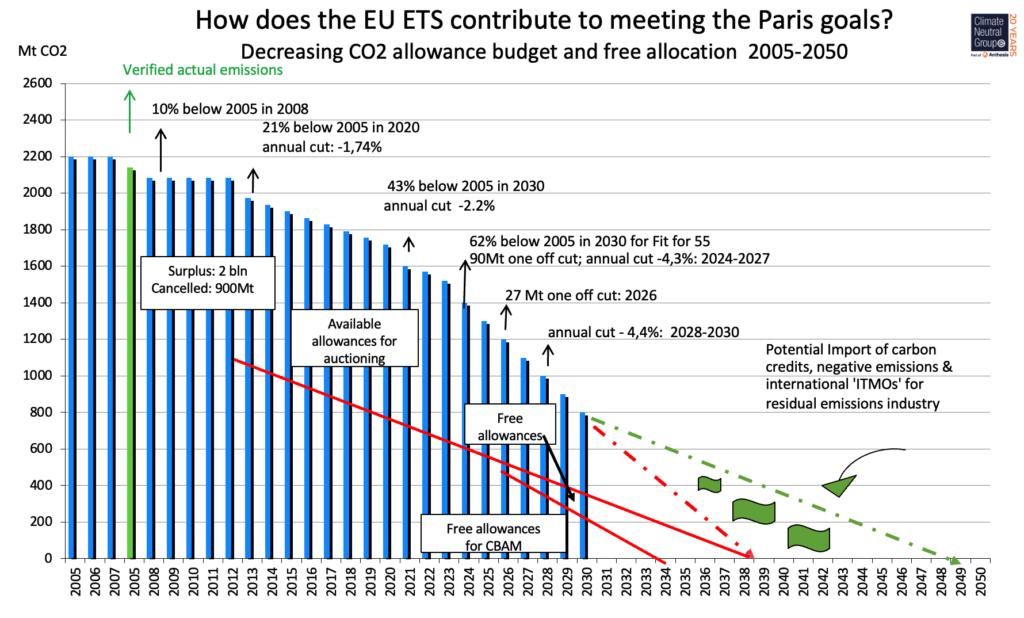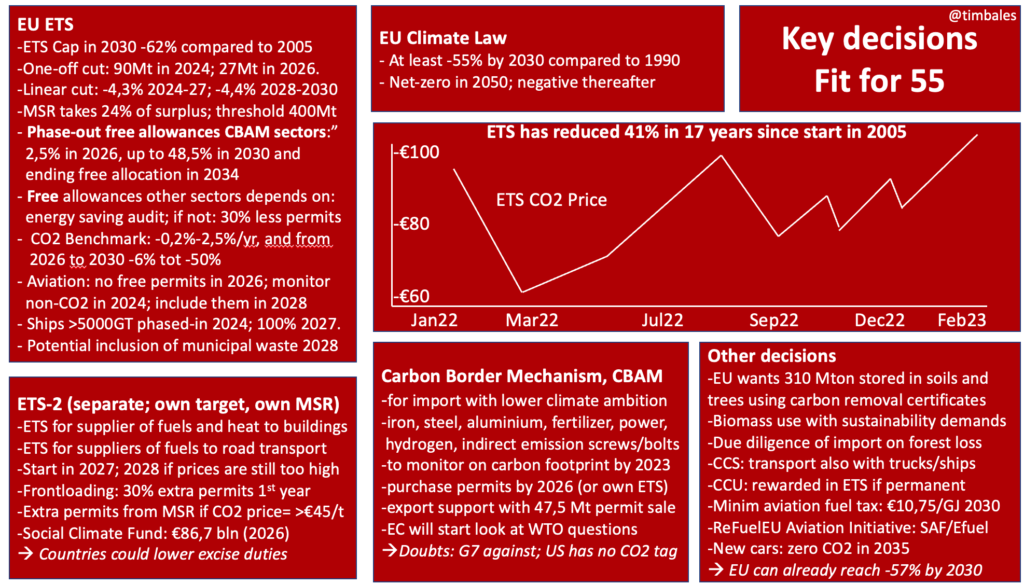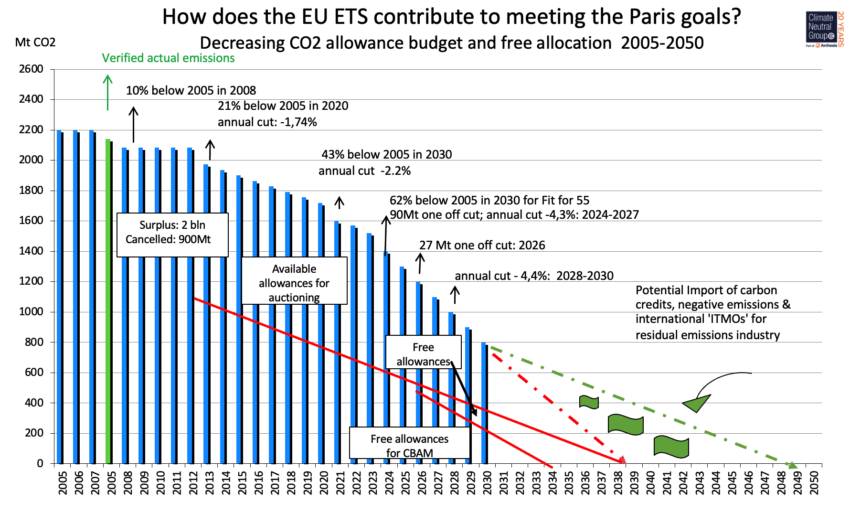The tightened and expanded ETS CO2 trading system is part of the so-called ‘Fit for 55’ package and helps to achieve the total CO2 target of 55% reduction in 2030 (laid down in the European Climate Act).
The new ETS is gratifying news: it leads to zero emissons already by 2039. With full implementation, the EU will already reach -57% in 2030. In the current discussion about ending fossil subsidies, it is overlooked that the fossil sectors already meet the CO2 targets
The European CO2 trading system (ETS) has been again on the radar of CEOs for a few years now. The approach to the surplus of emission allowances and the CO2 forward price curve forces them to make CO2-reducing investments. But envisaged ambition of the ETS to bring the EU to net zero more quickly will also come true. The upcoming tightening will already bring the total CO2 emissions of the more than 10,000 participants to 0 in 2039. After formal agreement of all parties and plenary vote of the European Parliament, the legislation will become final. See legal text.
An overview of the recent tightening and expansions.
Tightening ETS-1
- The CO2 cap will decrease slowly in the first years and faster from 2027 onwards. The target of the ETS will be 62% less CO2 emissions in 2030 (compared to 2005, the firts verified year). The number of available emission allowances – now being reduced by 2.2% annually – will decreas to 4.3% as of 2024 to 4.4% per year as of 2028. That is very ambitious because the efficiency impriovement usially increases by 1 to 2% per year. So additional investment is required.
- With the continued phasing out of 4.4% after 2030, no more emission allowances will be available in 2039 (see the decreasing number of available emission allowances in the table below). The European Commission is investigating whether ‘negative emissions’ (such as BECCS) and carbon removals (DAC) can then be added for the latest emissions in the industry (such as methane). The EU ETS can also be linked to other ETS systems or carbon credits from outside the EU in the context of the Paris Agreement for this purpose (the socalled ITMOs, Internationally Transferred Mitigation Outcomes).
- The remaining historical surplus of emission allowances will also be phased out because an additional 50 Mt of emission allowances will be canceled in 2024 and 27 Mt in 2026.
- The same over time sharpening effect is caused by the RePowerEU programme. The European Commission will auction 200-250 million emission allowances earlier (‘frontloading’) for extra income. This will be corrected later and less will be auctioned then. The effect of ther latter is that the CO2 price will be slightly reduced in the first years, and will increase slightly in later years. Analysts expect fewer rights to be bought at the auction in later years, resulting in even fewer auctions the following year. So this extra control button also raises the ultimate ambition.

Carbon Border Adjustment Mechanism (CBAM): A number of sectors will be protected against competing imports from countries with less ambitious climate policies or without a CO2 pricing system, to prevent carbon leakage (due to imports with more CO2 emissions). These importers will have to buy special CBAM allowances from the EU from 2026. The percentage of free emission allowances of European companies in CBAM sectors is being phased out. This concerns the following sectors: iron, steel, aluminium, fertilizer, electricity, hydrogen, downstream emissions from products such as screws and nuts. The right to free allowances for other industry depends on an energy audit: companies that do not take energy saving measures with a payback period of 3 years or less will receive 20% fewer free allowances. The 20% worst performing companies are required to draw up a climate plan. In principle, the amount of free allowances of the non-CBAM sectors is based on European CO2 benchmarks: x tons of free allowances per x ton of steel. The CO2 benchmarks will also be tightened (so fewer free allowances): between 0.2% and 2.5% per year and from 2026 to 2030 from 6% to 50%. Free intra-European aviation rights will be phased out more quickly and will end in 2026. Expansion scope current ETS-1 Waste incineration: monitoring emissions by 2024 and possible inclusion in the ETS by 2028. Member states already have the option to do this earlier with an opt-in. As of 2024, maritime shipping above 5,000 gross tonnage (GT) will become part of the ETS with a phase-in period until 2026 (especially cruise and container ships). For ships from outside the EU, 50% of the emissions are covered. After an evaluation, offshore service vessels and vessels between 400 and 5000 GT can also be added to ETS-2 in 2027. And methane, soot and nitrous oxide must be monitored and may become a mandatory part of the ETS in 2027.
Expansion with new ETS-2
- From 2027, there will be a separate emissions trading system with its own CO2 budget and its own rules for energy and fuel suppliers to the built environment and road transport. This gives those sectors a mandatory CO2 target and a CO2 price. And that promotes sustainable heat and cold supply to buildings and sustainable fuels. And in the long run it can make subsidies superfluous.
- From 2027, the ETS-2 will also be extended to fuel use in small industry.
- ETS-2 will have a number of safeguards to prevent the CO2 costs from becoming too high for tenants and motorists. Firstly, the start date can be postponed by a year (2028 instead of 2027) if energy prices are then too high. Second: If the CO2 price exceeds 45 euros per tonne of CO2 on average for two months, additional allowances will be auctioned from the market stability reserve.
- Part of the proceeds from the new ETS-2 will be used to finance the new Social Climate Fund (SCF). This fund aims to support vulnerable households and small businesses (insulation subsidy, public transport subsidy, etc.). The Netherlands could also reduce the excise duty on fuels, currently the highest in the EU, for the same purpose.
The tightened and expanded ETS, together with previous European agreements on the non-ETS sectors and on extra carbon sequestration in soils and trees, forms the complete so-called ‘Fit for 55’ package and helps to achieve the total CO2 target of 55% reduction in 2030 (laid down in the European Climate Law). With full implementation, the EU will even reach -57% in 2030. The agreed broadening will ensure that approximately 12% more emissions fall under the system. The upcoming Interdepartmental Policy Study (IBO) will also look at the effects of this European legislation.
This is important, because the effect of the ETS seems almost unknown to politicians, society and the media. Current campaigns by environmental groups and some political parties for a halt to fossil fuel subsidies, advertising and sponsorship of initiatives, and weekly climate press conferences as pressure on fossil fuel companies overlook the fact that through the ETS the CO2 emissions from fossil sectors must go to 0 before 2040. More attention should be paid to non-ETS sectors. That is difficult, because it affects us, how we eat, travel and enjoy ourselves.

